Hyderabad: Case files from ongoing proceedings 2020 north-east Delhi have reportedly shown that there is a whole lot of mismanagement and negligence with regard to how the cases are being handled. An investigative report by The Indian Express has stated that in some cases, charges of arson are not holding up to CCTV footages and that other discrepancies include one case being relied on for another.
The report has also said that a look at court orders in several riot cases points to some similarities in how proceedings are playing out.
One of the two judges at Karkardooma exclusiveky hearing riot cases, Vinod Yadav of the additional sessions court, has reportedly received over 179 cases for trial and framed charges in 57. The newspaper has reportedly accessed 27 orders in which charges have been framed by ASI Yadav’s court this year.
Key section dropped
IndianPenal Code (IPC) Section 436 (mischief by fire or explosive substance with intent to destroy house which carries a sentence of life imprisonment and a fine) is the most dropped section, a look at the court orders revealed, said the Indian Express report.
The section of arson gas been dropped in 12 court orders out of 27. In most of these cases, the allegation of arson was made by a police witness was junked by the court stating that this section cannot be invoked merely on the basis of police witnesses.
The court has also pulled up the police for clubbing incidents from different dates in some cases. For instance, The Indian Express said that on September 22, the court dropped the arson section against 10 persons, noting that police had clubbed incidents.
The court framed charges of arson only when the complainant in their statement sadi that the arson took place in 15 cases. Moreover, the police produced CCTV footage of burning motorcycles to make their case in a handful of them.
“There have been some lapses in investigation in arson cases. The officers in charge were overburdened with multiple cases and sometimes did not have a legal understanding of the section… There has to be a legally trained mind looking at these cases at the stage of registration of FIR… Whether this was a lapse on our part or if it was malafide is the question,” a senior official from the prosecution department said, The Indian Express reported.
CCTV footage
Police have relied on CCTV footage of one incident of rioting to implicate the accused in a different cased in several cases.
Additionally, it was found that police had arrested the accused on the basis of CCTV footage of a separate case in 16 orders. In other 11 cases, the police have not been able to produce footage. The court reported stated that the question of whether the accused can be arrested on the basis of CCTV footage of another case will be decided during trial.
The court also agreed with the prosecution that virtually every CCTV camera was broken during the riots in cases where there was no footage. The police reportedly also relied on ocular testimonies to bolster their case in some cases.
In some cases, Delhi police relied on ocular testimonies to bolster their case, the Indian express said and gave the example of a case where the court agreed with the defense counsel that the police witness in an arson case was three kilometres away from the incident. However, as there was an independent witness statement, it lent its weight to the case and charges were framed against the accused.
“In many cases, there has been an attempt to rope in as many people as possible. Criminal law is all about fixing liability. They have arrested people on the basis of CCTV footage in other cases. The people may be residents of that area, sharing their anxieties or talking amongst themselves, and it is not indicative of their participation in the riots. The courts have been asking these questions to the police, and they do not have answers,” said senior advocate Rebecca John, who flagged an issue with this approach, according to the Indian Express report.
A prosecution department official reportedly told the newspaper that police had established that the accused was present at one spot through CCTV; and through oral testimony, they placed the accused in the other spot. He further added that the burden to show proof that the accused was not present at the spot was on him. “Not having CCTV of one spot does not make it a bad case,” the official was quoted saying by the newspaper.

